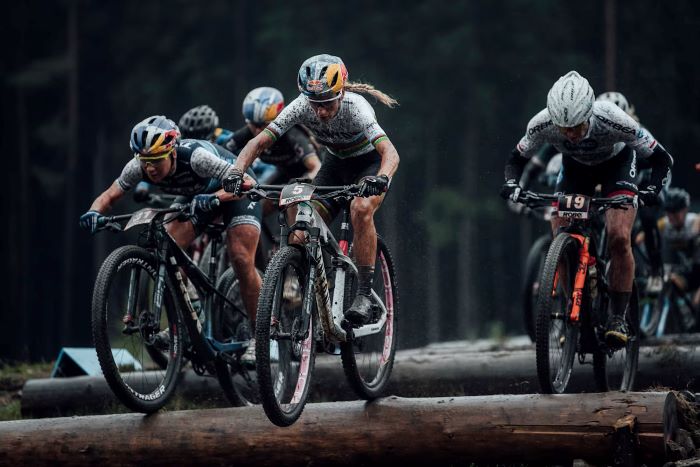Mountain biking is a sport that has grown in popularity in recent years. It involves riding a bike on rough, off-road terrain. But, many people wonder what XC is in mountain biking.
To begin with, for those who didn’t know, XC stands for cross country.
Cross country mountain biking is a sport that combines the challenge of a mountain bike ride with the added element of competition. So, cross-country mountain biking’s purpose is to finish a race as fast as possible among other cyclists.
Stay tuned and read this blog post until the end to learn about XC mountain biking and some of the most common questions people usually ask.
Table of Contents
What is Cross country (XC) Mountain Biking? History and Overview

XC mountain biking started in the early 1980s as a way for cyclists to challenge themselves on longer rides.
Cross country mountain biking (XC mountain biking) is a discipline of mountain biking in which riders attempt to cover the most significant distance possible over rough terrain in a single ride.
Unlike other types of mountain biking, this type generally involves pedaling for most of the ride. This makes XC mountain biking a very physically demanding sport requiring a great amount of stamina and endurance to achieve great results.
Today, XC mountain biking has become a popular sport with many different disciplines, from racing to recreational riding. No matter how you choose to ride, cross country is a great way to get outside and explore the world around you.
The race types of cross-country cycling
We can divide XC or Cross-country cycling into four different subcategories, which are:
- (XCE) Cross-Country Eliminator
- (XCO) Cross-Country Olympic
- (XCC) Cross-Country Short Circuit
- (XCM) Cross-Country Marathon
The main difference between these four subcategories is that they differ in the length of the track distance. For example, Cross-Country Marathon is way longer than the Cross-Country Short Circuit in the distance.
However, let’s analyze them more in-depth below to let you understand.
(XCE) Cross-Country Eliminator
A competition in which the top two first riders advance to the next phase and the last two riders are out. The maximum duration of each race is 60 seconds.
(XCO) Cross-Country Olympic
The goal of this competition is to complete several laps of the 2.5-6.0 mile (4-10 km) race track in the elite class for approximately 90 minutes. In addition, this is the only cross-country event included in the Olympic games.
(XCC) Cross-Country Short Circuit
This race is similar to the XCO but typically less than 1.0-2.0 km (0.6-1.2 miles) in laps and lasts 20-25 minutes on non-technical terrain.
The total laps are defined by how many laps riders make within that time frame, given the maximum previous lap time specified. XCC races usually determine the order in which a racer participates in his XCO races and are typically held two days before him in the XCO races to pick the starting order.
(XCM) Cross-Country Marathon
The length of these races is typically 65 to 100 km. Participating in XCM competitions has become more prevalent in recent years because it has a large crowd of fans, and everyone can participate, even beginner riders.
Cross-country biking equipment
Before going for an XC biking training or to a competition, you’ll need these things I mention below because these are probably the essential items you need as a cross-country cyclist to have with you for any case and emergency.
Here’s the list of the items you need to bring with you:
- Water bottles and a cage or two to hold them
- A spare tube or two, a patch kit, and a pump
- A headlight and taillight
- A reflective vest or other gear to make yourself more visible
- A credit card and some cash, in case of an emergency
Also, you can bring more items if you think they are crucial for you and your safety, but I think these are enough for a cross-country cyclist.
Is XC mountain biking an Olympic sport?
The answer is yes. XC mountain biking has been an official Olympic sport since 1996, and in general, it has to do with racing over hilly or mountainous terrain for a couple of kilometres.
Mountain biking made its Olympic debut at the 1996 Summer Games in Atlanta and has been a part of the Games ever since.
XC mountain biking, or cross-country mountain biking, is one of the four subcategories of mountain biking, but this is the only one included as an official Olympic sport.
Is cross-country mountain biking hard?
Cross-country mountain biking is a challenging sport. While it can be challenging at most times, it is also an incredible experience.
So if you’re wondering if cross-country mountain biking is challenging, the answer is yes and no. It cannot be easy for beginners, but it is also a delightful and rewarding experience for more advanced cyclists.
There are few things more satisfying than completing a long and challenging cross-country mountain bike ride, and if you have already done it, then I can already read your mind that you agree with me.
Overall I can not say that cross-country racing is for everyone. The reason behind this is that it requires a lot of preparation and training, both mentally and physically.
It is also essential to start slight and then improve step by step your process to build a habit and get the appropriate experience for this type of cycling. However, with preparation, determination and consistency, I guarantee the results will be positive for you.
How long is an MTB cross-country race?
Before revealing the distance of these races, the XC mountain biking races typically take place in places that are as challenging as possible, including plenty of hills, rocks, and other obstacles to make it more difficult for the competitors.
Overall, the race maps of these races usually take place in mountains and forests that include all the above I just mentioned.
The actual length of a mountain biking cross country can vary across the competition, government and the participants. In general, a race length can be 10km long, or even 138km in the distance from start to finish, as in the Olympics.
As a result, there is no fixed number for an MTB cross-country race’s total length and distance because we can see many small and big track lengths. Also, an XC race can last half an hour or up to several hours based on the track size!
What is an XC bike used for?
XC bikes are mainly used to ride offroad and as fast as possible, which means they are light and efficient on uphill climbs and fast on descents.
This type of bike is typically lighter and faster than other mountain bike types, making it ideal for riders who want to cover a lot of ground quickly. XC bikes are also often used in racing, as they can go through various terrain at high speeds.
Most XC bikes have suspension forks to absorb impacts on rough terrain, and some even have full suspension for even more comfort and control. If you’re looking to get into competitive mountain biking races or explore the challenging terrain of a mountain “in the first person”, an XC bike is a great choice.
How fast are cross-country bikes?
The fastest cross-country bikes are lightweight, with low gears and a narrow wheelbase. Their design allows these bikes to perform well on rugged terrains while maintaining speed and balance.
Regarding the speed of cross-country bikes, In the United States, the average speed rate of a cross-country bike is 9 miles per hour, and in Europe, it’s around 15 kilometres per hour.
Cross country bikes are not as heavy as other types of bikes, which makes them more agile and able to handle rugged terrain. They have a lower gear ratio than different mountain bike types, allowing riders to go up steep hills more easily. The narrow wheelbase helps the rider navigate through tight turns on challenging trails.
Also read: How Fast Does A Mountain Bike Go?
Conclusion
Mountain biking is a great way to get exercise and enjoy the outdoors. It can also be a competitive sport if you want to enter a cross-country mountain biking competition but remember that you need to be focused and determined to participate in a race like this. Although, there are many mountain biking competitions held each year. We hope that you found our article useful and helpful to you by providing you with the answers about cross-country mountain biking. If you have any other questions feel free to contact us for more clarification.

Daniel, a mountain biking expert with a Master’s degree in Sports Science, has over 10 years of experience navigating the toughest trails. With a passion for sustainable riding, he shares expert tips and gear advice on mountainbikerz.com. Join his 145K followers on Instagram.

